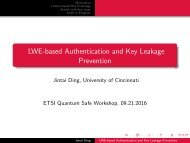RedirectToSMB_public_whitepaper
RedirectToSMB_public_whitepaper
RedirectToSMB_public_whitepaper
You also want an ePaper? Increase the reach of your titles
YUMPU automatically turns print PDFs into web optimized ePapers that Google loves.
REDIRECT TO SMB<br />
For most configurations these authentication requests will be encrypted, but the supported<br />
encryption methods are far from state of the art. An unsophisticated attacker would be capable<br />
of recovering most passwords in a few hours or days depending on available hardware, even<br />
in some cases where password policies are applied. These recovered credentials could then<br />
be used to authenticate with the victim’s computer or domain.<br />
The effects of stolen Windows domain credentials can be devastating, as was observed from<br />
the result of the compromise at Sony Pictures Entertainment (http://www.cnn.com/2014/12/18/<br />
politics/u-s-will-respond-to-north-korea-hack/). Enumerating the potential downfalls of stolen<br />
credentials are not in the scope of this document, but it can include access to network shares,<br />
executing of code with applications such as PsExec, RDP access, Windows Live account<br />
access, and much more.<br />
2.1 – Previous Research<br />
The original method of attack was reported by Aaron Spangler to Microsoft in 1997, as it<br />
affected Internet Explorer 3 (http://insecure.org/sploits/winnt.automatic.authentication.html).<br />
It was this initial discovery and subsequent <strong>public</strong> Proof of Concept that allowed the security<br />
community to react and defend against an issue that, unfortunately, we still face today. We did<br />
not feel right building upon this research without paying the proper respect first.<br />
3.0 – Redirect to SMB<br />
Redirect to SMB is an attack that opens additional methods to exploit the aforementioned<br />
issue. In the Redirect to SMB attack, a vulnerable client attempting to access a web resource<br />
is redirected to authenticate with a SMB server. This can be done through a variety of methods,<br />
the simplest of which is returning a HTTP redirect status code (301 or 302), which informs the<br />
browser the resource it is attempting to access has moved, then supplying a path that begins<br />
with ‘file://1.1.1.1/’ where 1.1.1.1 hosts a logging SMB server. Assuming the client is vulnerable, it will<br />
attempt to authenticate with the SMB server, which logs the authentication attempt.<br />
[See figure 2 on the following page]<br />
This method has proved to be dangerous and increases the attack surface. Previously, many<br />
methods of attack surrounding SMB credentials have relied on SMB share mounting or<br />
opening a malicious link in a browser. But redirecting HTTP (and insecure HTTPS) traffic allows<br />
for exploitation of mechanisms such as update checks, usage reporting and bug reporting.<br />
In some cases, we have found login mechanisms to be vulnerable, as well as advertisements<br />
embedded into applications. Requests to licensing servers could be exploited, as well as<br />
downloading dependencies during installation processes.<br />
[See figure 3 on the following page]<br />
03



